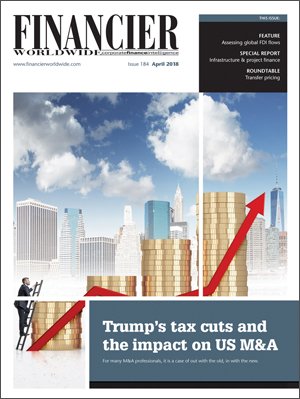Getting gender pay parity right
April 2018 | FEATURE | LABOUR & EMPLOYMENT
Financier Worldwide Magazine
Women represent 50 percent of the global working-age population and are responsible for 37 percent of global GDP, yet a gender imbalance persists in the boardroom as well as in pay packets. According to the Institute for Women’s Policy Research, in the US, women make 76 cents to a man’s dollar.
A generational shift is occurring, however, with millennial women in particular closing the pay gap on their male counterparts – yet a gap still exists. According to a 2017 World Economic Forum report, at the current rate, it will take 217 years for disparities in the pay and employment opportunities of men and women to end. A year earlier, the Forum predicted that it would take 170 years to close the gap.
Saadia Zahidi, the Forum’s head of education, gender and work, said: “We should not be seeing progress towards gender parity shift into reverse. Gender equality is both a moral and economic imperative. Some countries understand this and they are now seeing dividends from the proactive measures they have taken to address their gender gaps.” And some countries are making great strides. In Iceland, companies with more than 250 employees must now prove that they pay male and female employees in the same job equally. Those that fail to comply may be fined around $500 per day.
Growth boost
Reports suggest that closing the gender pay gap would provide a significant boost to the global economy. The Organisation for Economic Co-operation and Development (OECD) believes that achieving gender pay parity would increase GDP by 12 percent in developed countries over the next 20 years.
There is, however, a long way to go. The Office for National Statistics in the UK found that the gender pay gap for full-time workers is entirely in favour of men for all occupations. Across all industries, women’s pay grows less than men’s and also stops growing earlier than men’s pay in both the private and public sectors. Though this data does not take into consideration issues such as education and career breaks, there is clearly an issue, be it organisational or cultural.
“If companies – and governments – are serious about bridging the gender gap, wage auditing and reporting should be compulsory.”
There are many reasons why women are held back in the workplace, from gender bias and stereotyping, to a lack of role models and exclusion from informal networks. Women’s professional development is often neglected by organisations, or, in some cases, wilfully ignored.
Attitudes must be changed, be it via activism, legislation or litigation. Transparency in gender pay reporting is a must, as it signals a company’s commitment to equality and encourages employees to contribute to the dialogue in a meaningful way. Legislation introduced in the UK in December 2016 requires companies with more than 250 employees to publish their gender pay gap data, as well as publish a written statement on their public-facing website. Companies must also report their data to the government online, using the gender pay gap reporting service.
Though there are undoubtedly benefits, these measures have attracted criticism for not doing enough to have any meaningful impact on the gender pay gap. Data released by the UK government in late February showed that 74 percent of UK firms with more than 250 employees pay higher rates to their male staff. Fifteen percent of companies pay women more and 11 percent said there was no difference. The average gender pay gap across all medium and large-sized firms in the UK is now 8.2 percent, as measured by median pay.
From a company perspective, reporting pay gaps can help attract and retain talent. According to a 2016 Business in the Community survey, 92 percent of employees surveyed said that they consider pay gap data when applying for jobs and deciding between two employers. Furthermore, more than half of female respondents said they would favour the company with the smallest pay gap or the one that is more proactive in closing it.
If companies – and governments – are serious about bridging the gender gap, wage auditing and reporting should be compulsory. Organisations must understand that they have a problem and then analyse the data to find out what the gap is and where it is, before addressing it.
Of course, gender pay parity is only part of the wider diversity issue which affects many organisations globally. Creating an effective inclusion and diversity strategy is a complex process which requires strong leadership. The financial case is there for hiring and better remunerating marginalised sections of our society. Bridging the gender pay gap is possible and legislation has an important role to play. However, pay equality will require more than just legislation. It will require a sea-change in management thinking. Male employees must also be willing to lean in.
© Financier Worldwide
BY
Richard Summerfield

